Mansaf is a traditional Jordanian meal made of lamb and rice, seasoned with a unique yogurt sauce. For an authentic taste of Jordan, this recipe is a must-try!
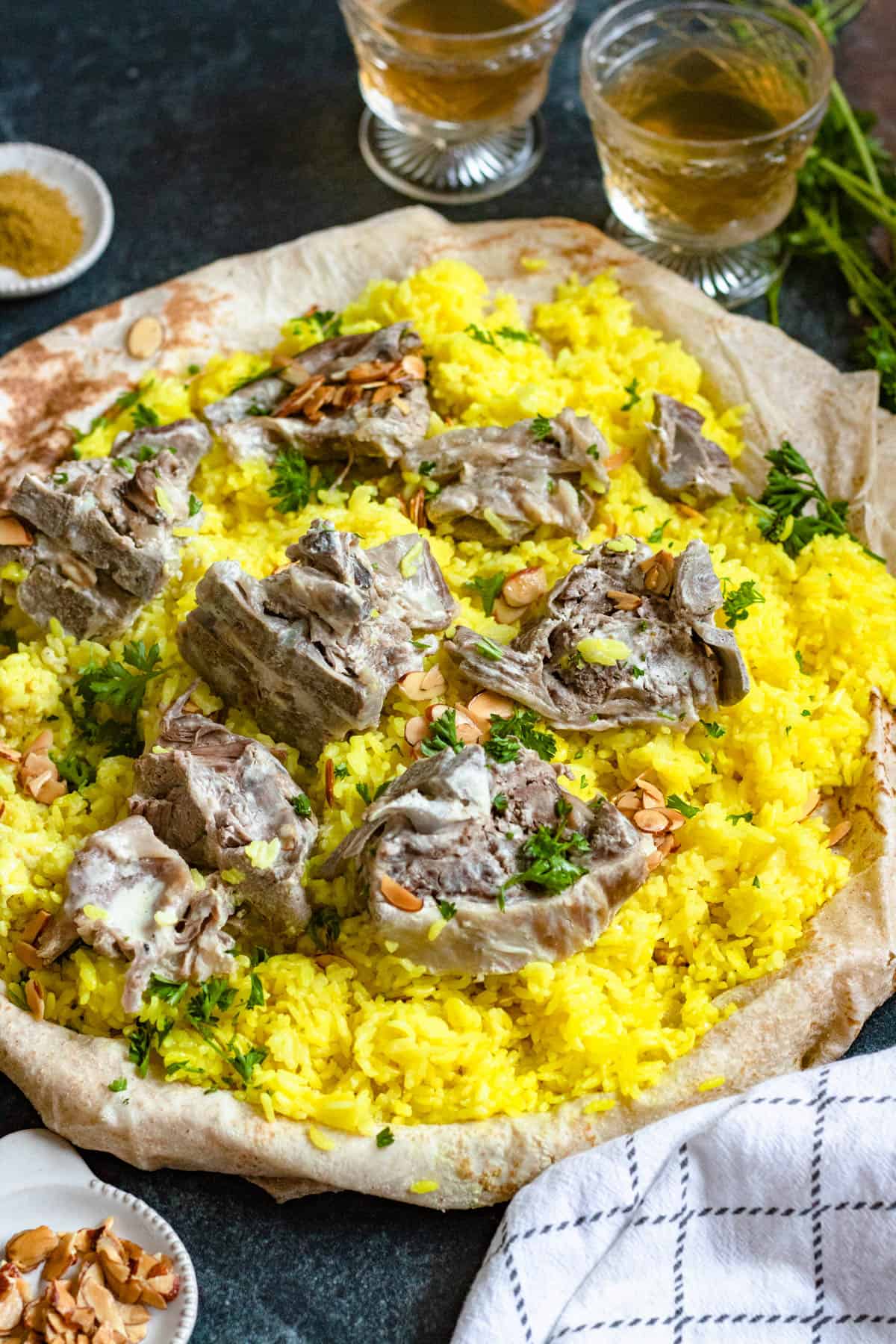
Hello Reader! I try my hardest to research recipes as best as I can before posting to ensure I am representing each culture correctly. If this recipe is from your country and I have made a mistake or you have suggestions for how to make it more authentic, I would love to hear! Please leave a comment below letting me know what should be different, and I will rework the recipe. It is always my intention to pay homage and respect to each cultural dish that I cook. Thanks for reading!
Mansaf is a traditional dish from ancient times that has only grown in popularity over the years.
You can find families enjoying mansaf at home across the Middle East and can even see it served at special occasions like religious holidays, weddings, or funerals.
Maybe the reason why mansaf has stood the test of time is that it uses ingredients that are common to the area. It is filling, warm and comforting, and is served in a way that encourages gathering.
Mansaf consists of thin bread soaked in a yogurt sauce and then layered with rice, tender pieces of lamb, and a sprinkling of toasted nuts. With each bite, you take a scoop of it all and let the bread and rice, soaked in a distinct yogurt sauce, combine with the savory flavor of lamb that melts in your mouth. Try serving it with a Kenyan recipe, sukuma wiki, to get in some healthy green vegetables
No matter how you enjoy it, it’s a dish you won’t soon forget. The flavor is unique, the texture is tender, and with the perfect combination of lamb, rice, bread, and sauce, by the end of the meal, you are sure to feel satisfied.
Another impressive dish prepared with lamb that you can enjoy for a weeknight dinner or for a fun presentation to dinner guests is Beshmarbak – a traditional Kazakhstan dish.
Recipe Origins
The original mansaf recipe came from the Bedouins, a nomadic Arab people, and dates back to as early as the 10th century.
At that time the recipe for mansaf consisted mostly of lamb cooked in yogurt and served over bread. The people would use fresh yogurt in the spring and dry yogurt, called jameed, in the off-season when milk products were harder to find.
As more Bedouins settled into Jordan and Palestine, they shared this culinary tradition and it began to modernize. Today mansaf is considered the national dish of Jordan.
Over time people began to incorporate rice into the dish to make it even more filling and toasted nuts for more flavor.
Mansaf was traditionally served on very large platters, several feet wide, so guests could come together around the platter and eat off it as a communal plate. Some men still enjoy mansaf in this manner, but most people will scoop their own portion onto a plate to enjoy with a fork.
Why Make This Recipe
- Distinct Flavor: Mansaf has a distinct flavor you won’t get through many other dishes. Jameed had a unique flavor you can’t get from anything else.
- Made to Share: This dish comes together beautifully on a platter and makes enough to share with a lot of people. Mansaf is the perfect dish to serve to a crowd of adventurous eaters.
- Taste of Jordan: Jordanian cuisine is something special and this dish is quintessentially Jordanian. Bring a little bit of Jordan into your home by enjoying this national dish!
What Do I Need To Make This Recipe?
Ingredients
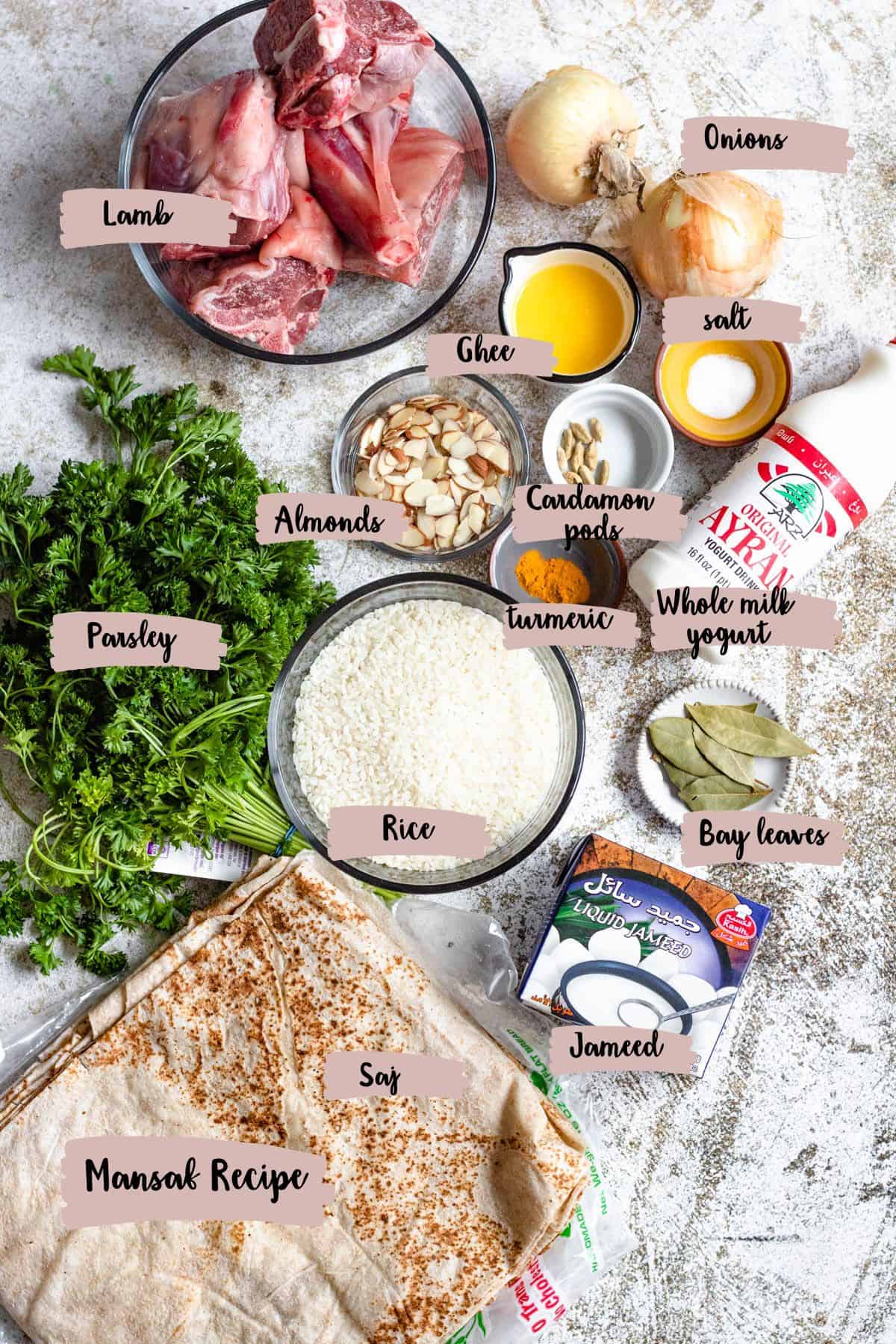
Here is a visual overview of the ingredients in the recipe. Scroll down to the recipe at the bottom for quantities.
- Bone-in lamb shoulder, cut into large pieces: I went to my local Middle Eastern grocery store and asked for lamb shoulder. The butcher counter was able to cut the meat into 4-6 inch pieces for me (I told them I was making Mansaf, and they knew how to cut it!).
- Distilled White Vinegar: To clean your lamb.
- Calrose Rice: This is a short-grain white rice that our recipe editor recommends for the best results! Other recipes sometimes call for jasmine rice.
- Liquid Jameed: See the “What is Jameed” section below for more information.
- Whole Milk Yogurt: You do not need Greek yogurt. Instead, use regular, whole-milk yogurt.
- Maqluba Spice: I found this at my local Middle Eastern grocery store but you can also find it online. If you cannot find it, you can omit it.
- Saj, Shrak bread, Markook, or Lavash bread: This is a very thin bread, thinner than a tortilla. You could use tortillas or pieces of flatbread if you cannot find these other breads.
- Parsley: For garnishment
What is Jameed?
Jameed is the key ingredient for mansaf, but it may be difficult to find in the US. Jameed translates to “hard yogurt”, and it is a fermented milk product. Jameed is essentially a dried yogurt or cheese from goat milk. The yogurt is dried until it forms a rock-hard ball in the shape of an egg (but a little larger). It was originally prepared in this manner to preserve dairy without refrigeration through multiple seasons.
If using the dried jameed, you will need to rehydrate it before using it.
Most of the jameed you can find in stores has already been reconstituted into readily available liquid jameed or soup starter, which is what this Jordanian mansaf recipe calls for. Two popular brands are Ziyad and Kasih.
I found this at my local Middle Eastern grocery store! It comes in a large box that has two smaller boxes of jameed inside. You will only need one of the smaller boxes of jameed for this recipe.
The liquid jameed is salty and sour. My recipe also calls for plain yogurt for additional flavor. In my opinion, the use of yogurt and jameed gives you excellent flavor while keeping it as close to authentic as possible in the mansaf.
I have seen some recipes use a combination of yogurt with added lemon juice instead of jameed, to try to mimic jameed’s sour taste. If you try to do this I recommend using a thick Greek yogurt for the best flavor. I do highly recommend trying to find liquid jameed before making this substitution because nothing beats the original version of this recipe!
Tools
- Large pot
- Pressure cooker or instant pot (optional)
How to Make This Recipe
Step One: Prepare the Lamb
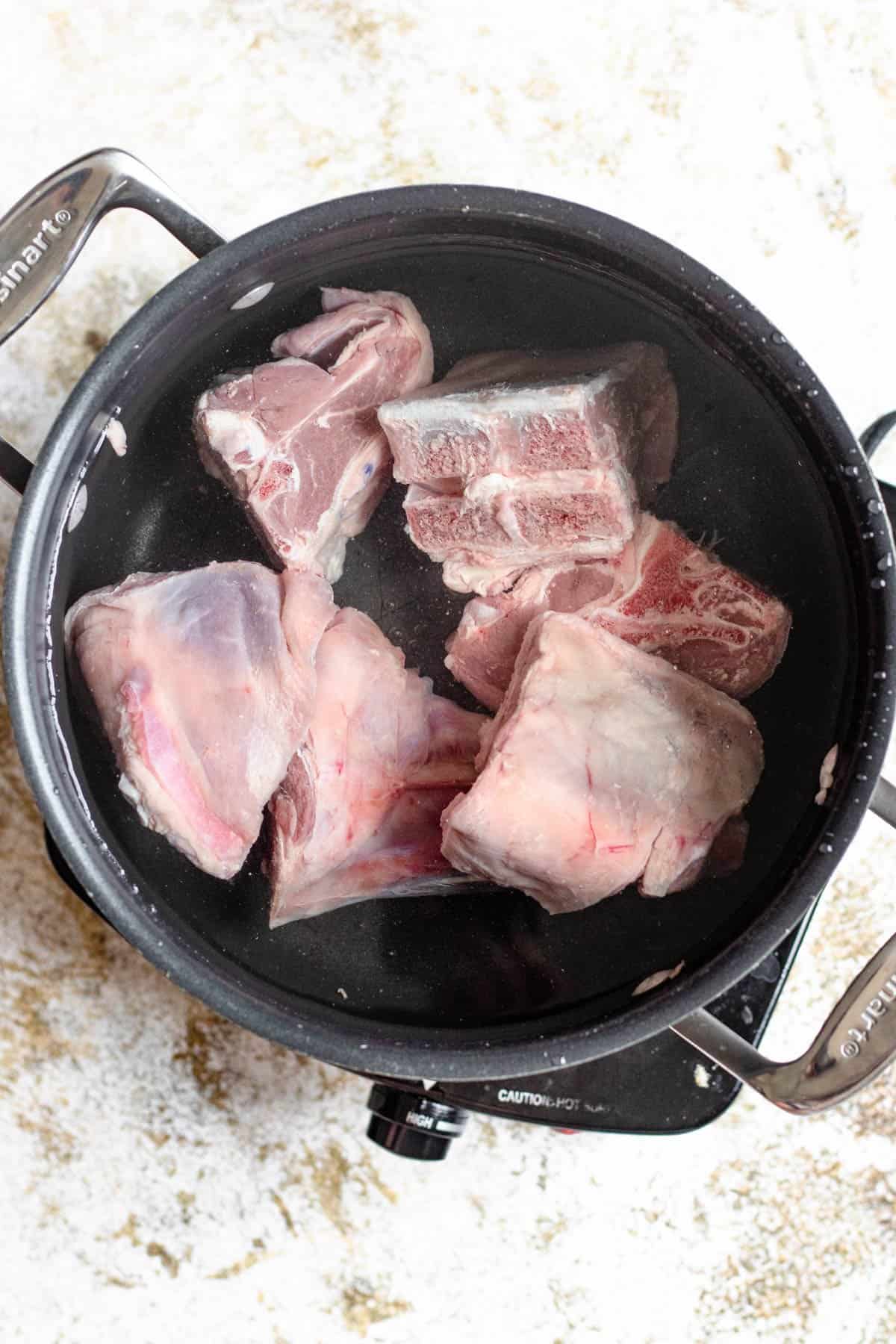
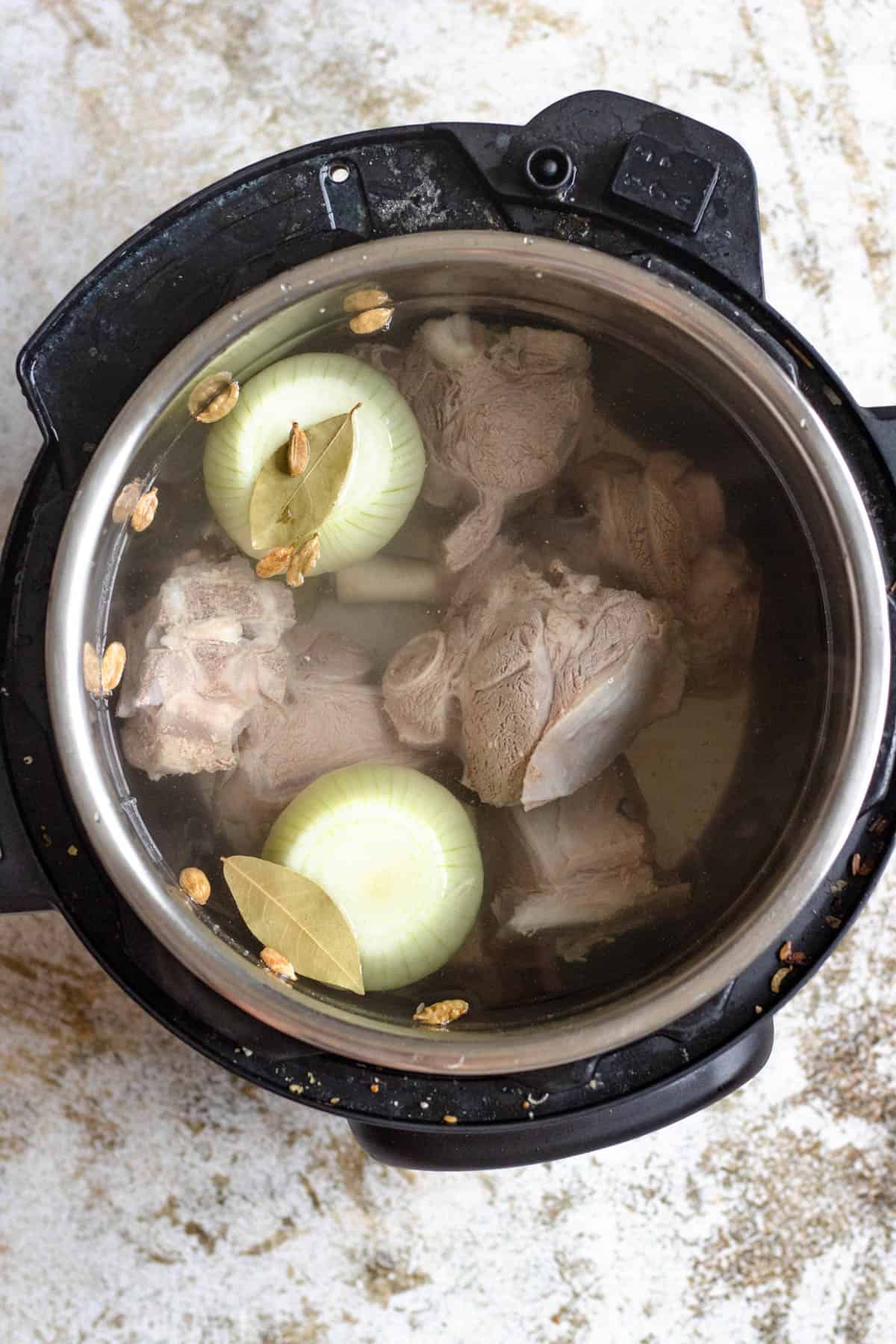
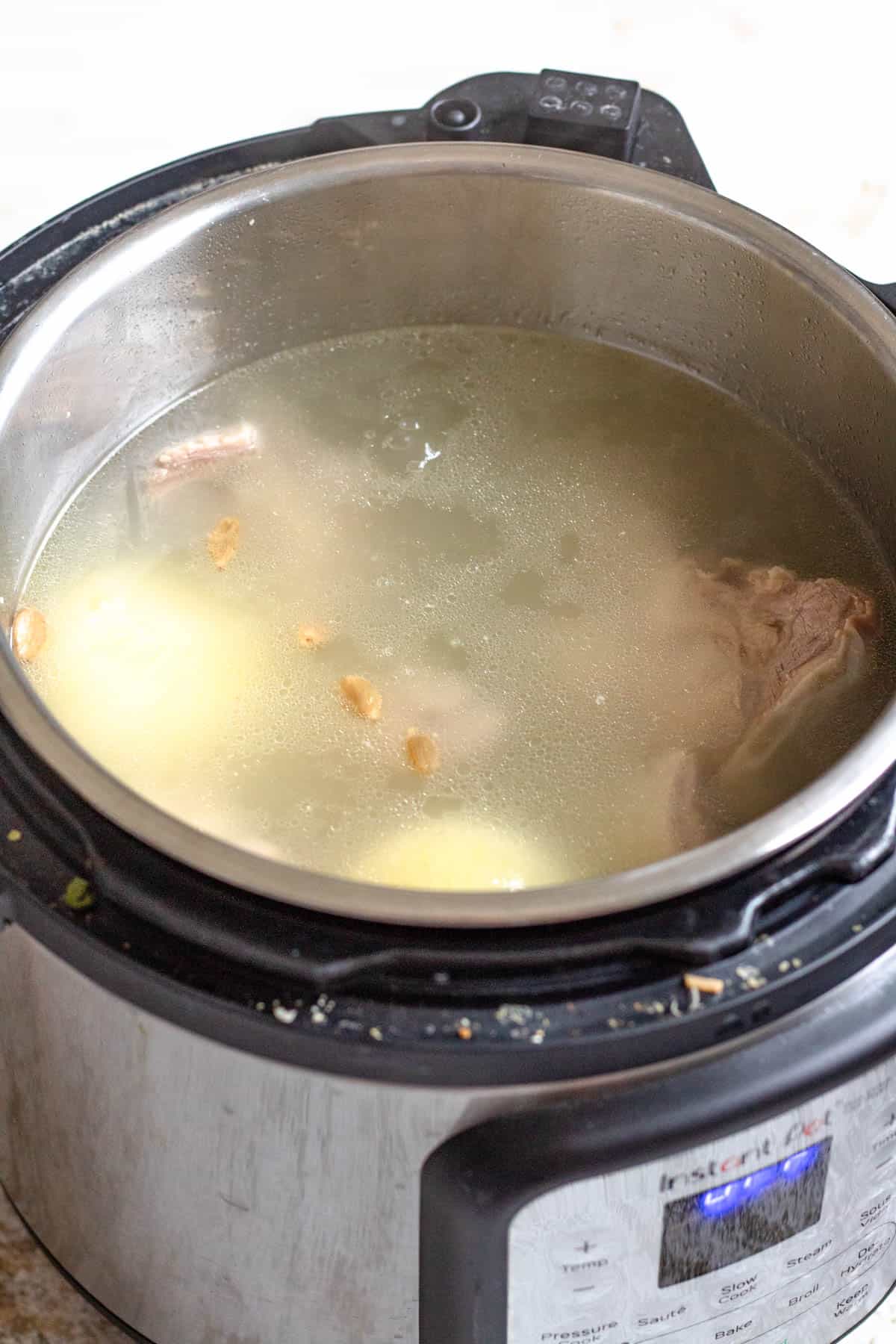
Rinse the lamb meat with cold water and splash it with distilled white vinegar. Rub the vinegar into the lamb, then rinse with more water.
Put the lamb in a large pot and then pour in enough water to completely cover the lamb. Turn the stove to medium-high heat.
Put the lid on and boil the lamb for ten minutes. You should notice foam forming at the top of the pot. Make sure to skim this foam off of the top of the water.
After 10 minutes, dump the boiling water out. Then rinse the meat again, and add it to a pressure cooker with the yellow onions, bay leaves, and cardamom pods. Fill the pot with enough water to completely cover the contents of the pot.
Set the pressure cooker to high for 30 minutes. If using the stovetop method instead of the pressure cooker, return the lid to the pot and allow it to boil for 1-2 hours.
The stock is done when the meat is tender and a butter knife can easily poke through the meat. Remove the meat from the liquid with a slotted spoon. Strain and reserve the stock and set the stock and meat aside.
Step Two: Prepare the Rice
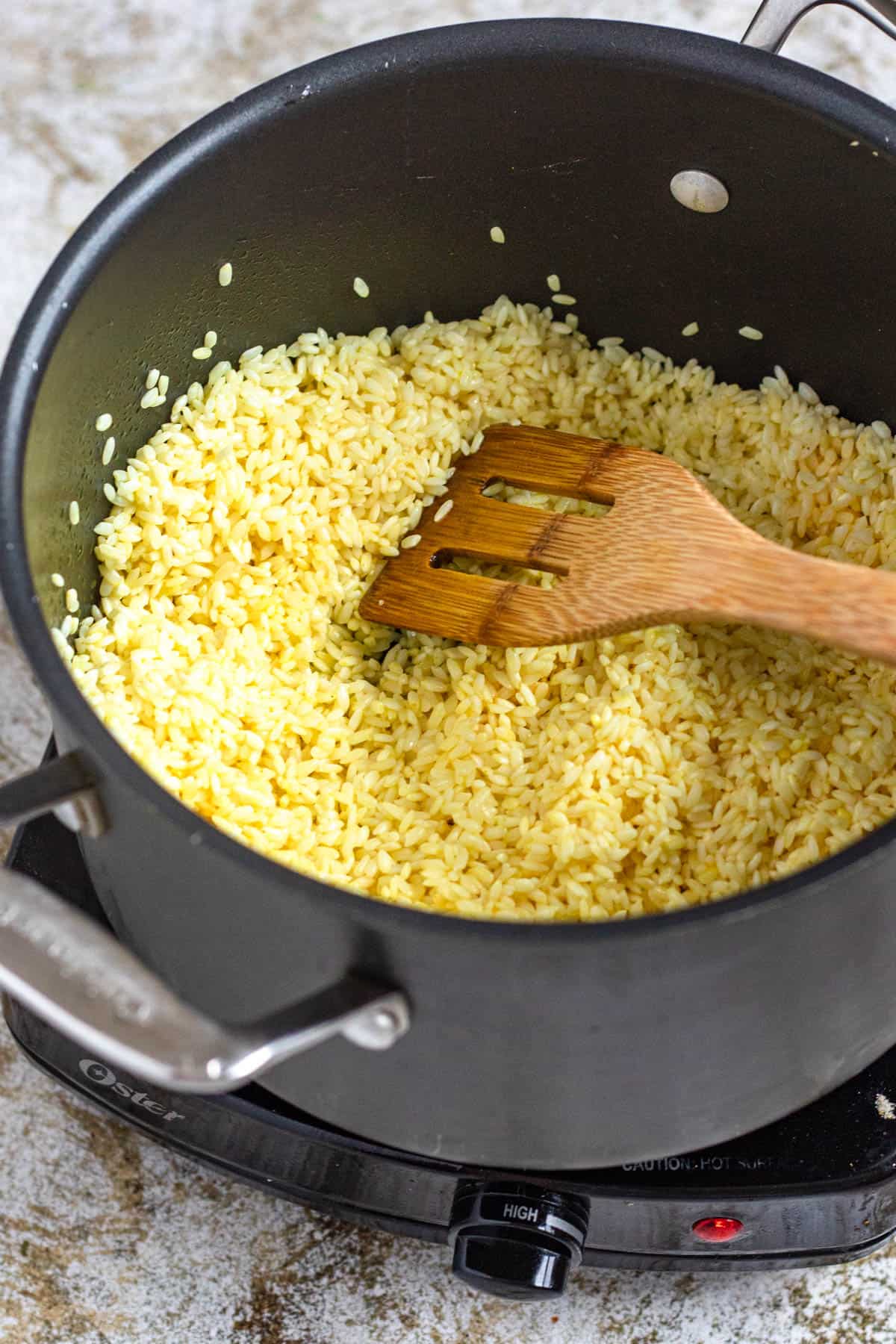
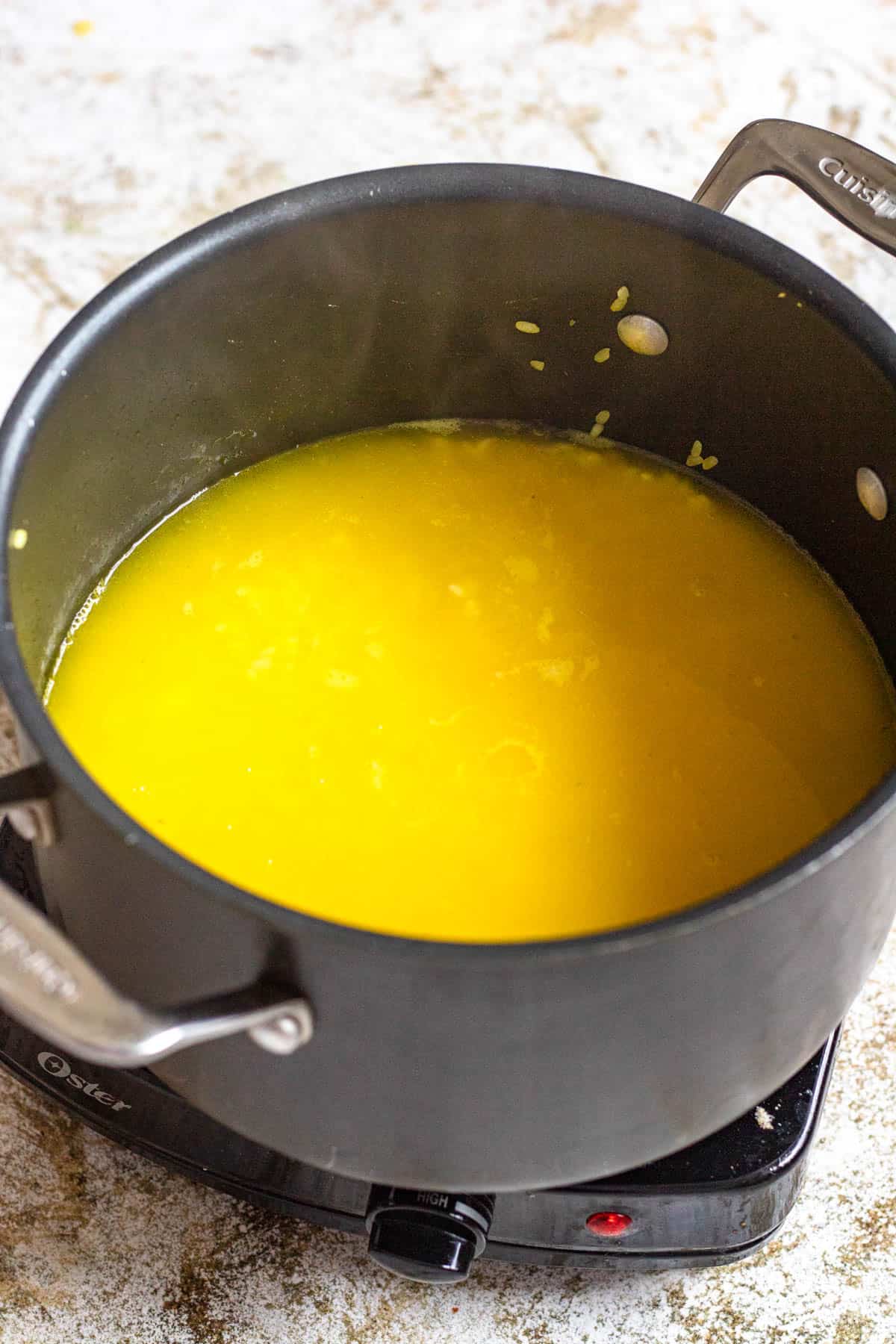
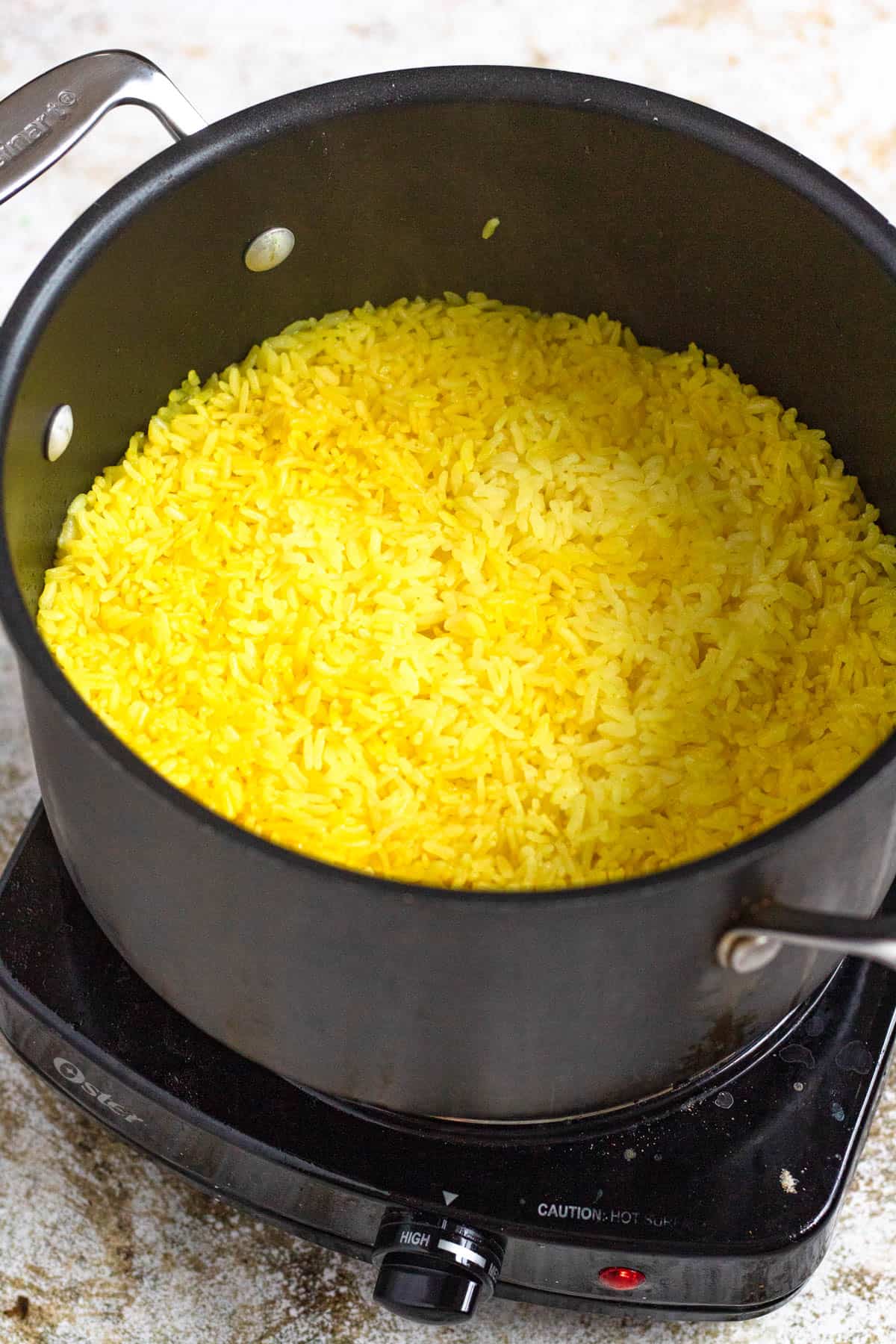
Once the meat is done, add 1 tbsp ghee to a medium pot. Allow the ghee to melt, then add salt and turmeric.
Add the soaked and drained rice and stir to toast in the ghee for a few minutes.
Add 3 ⅓ cups of the reserved stock into the pot with the rice. Bring the water to a boil, uncovered, then reduce to a simmer.
Turn the heat to low, put a lid on the rice and cook until the water is absorbed and the rice is cooked (about 15 minutes).
Step Three: Prepare the Jameed
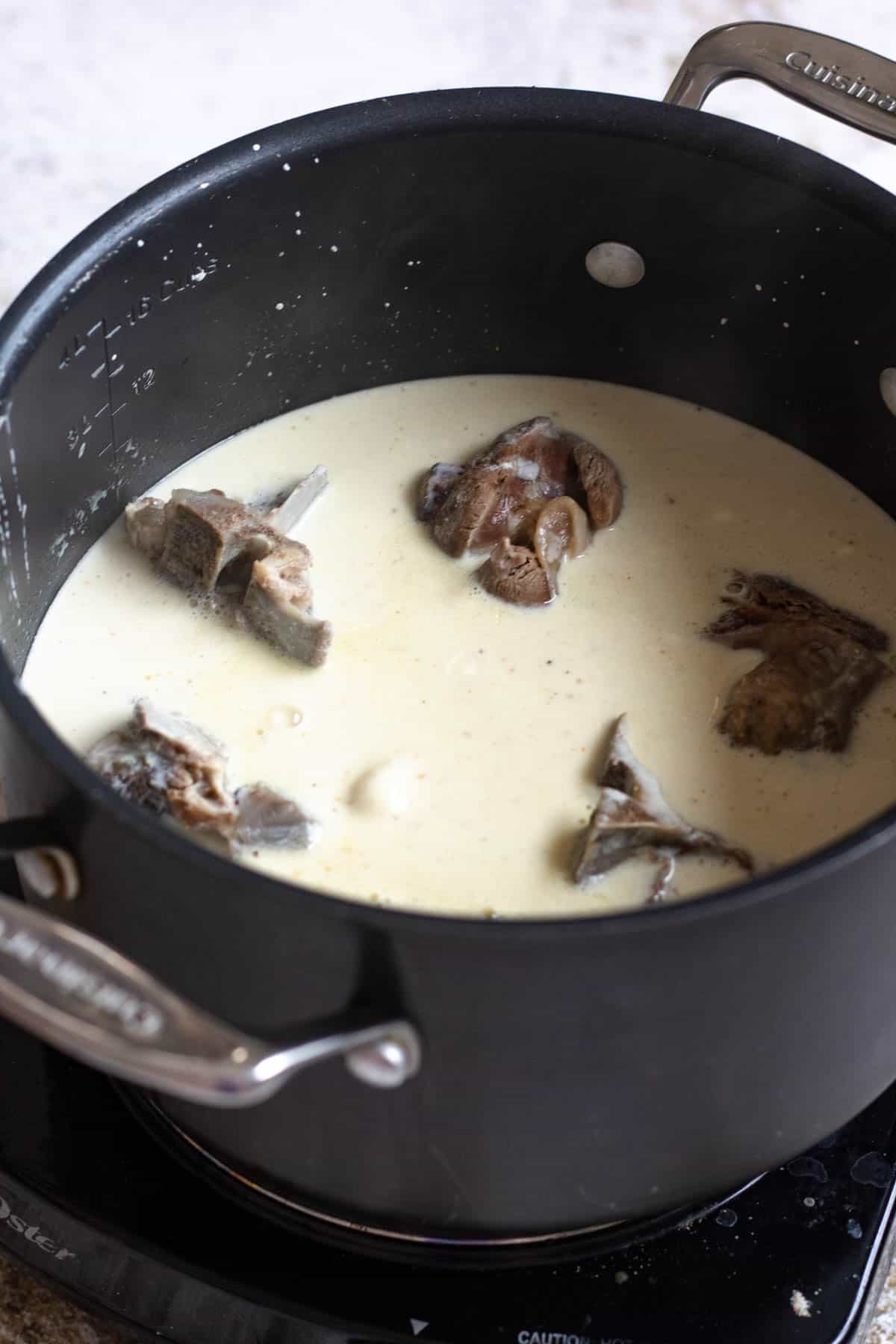
Pour your jameed into a small pot, then add the yogurt and about 1 cup of the reserved stock.
Let this mixture come to a simmer for about 10 minutes. Mix carefully. Do not boil it and do NOT cover the pot.
When the jameed has simmered for 10 minutes, add the maqluba spice and the lamb pieces into the pot and simmer for another 10 minutes.
When the 10 minutes are up, remove the lamb from the jameed and set both aside.
Step Four: Prepare the Almonds
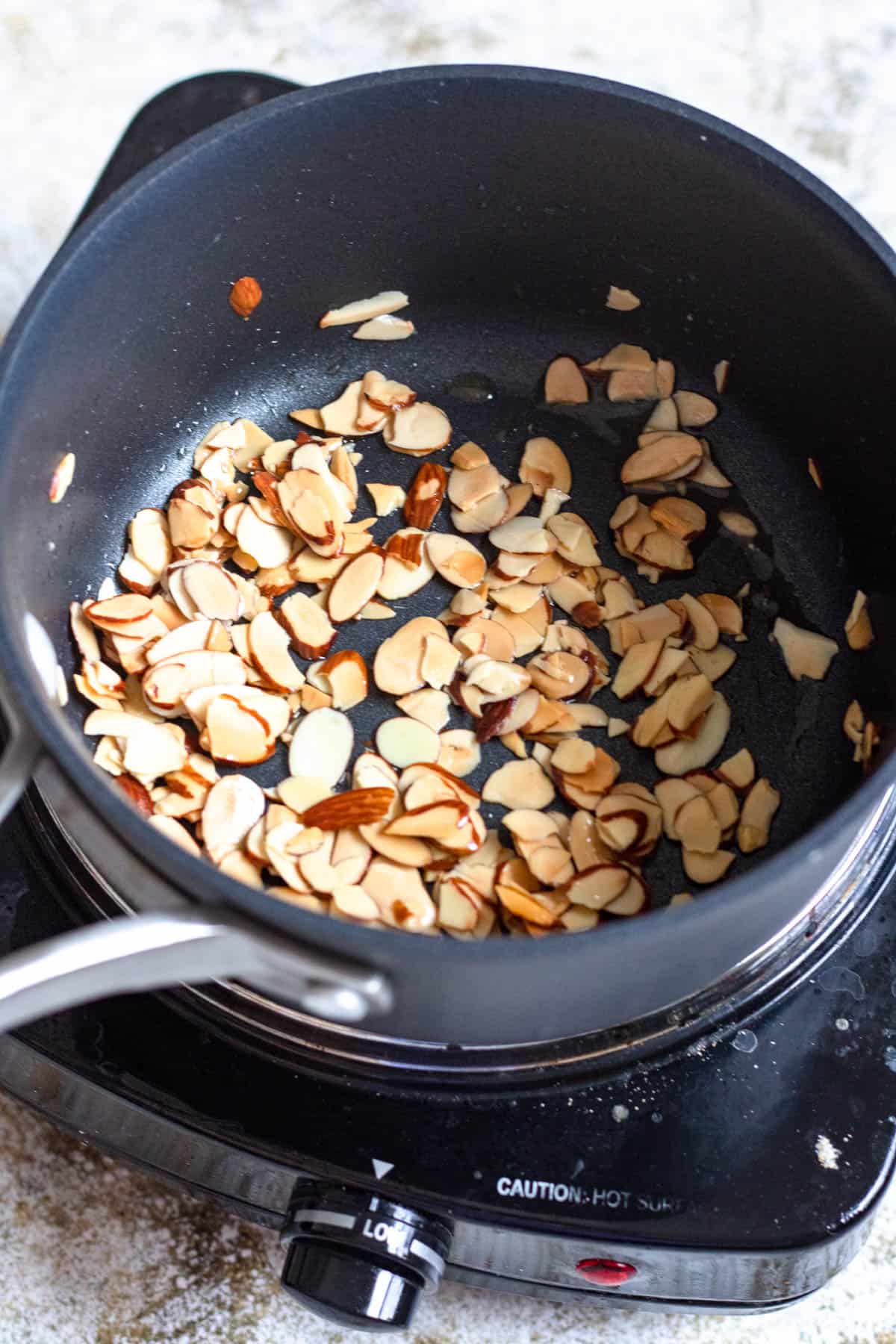
Heat another 1 tbsp of ghee in a pot and melt. Then add the ¼ cup almonds. Stir until the almonds are toasted.
Step Five: Serve
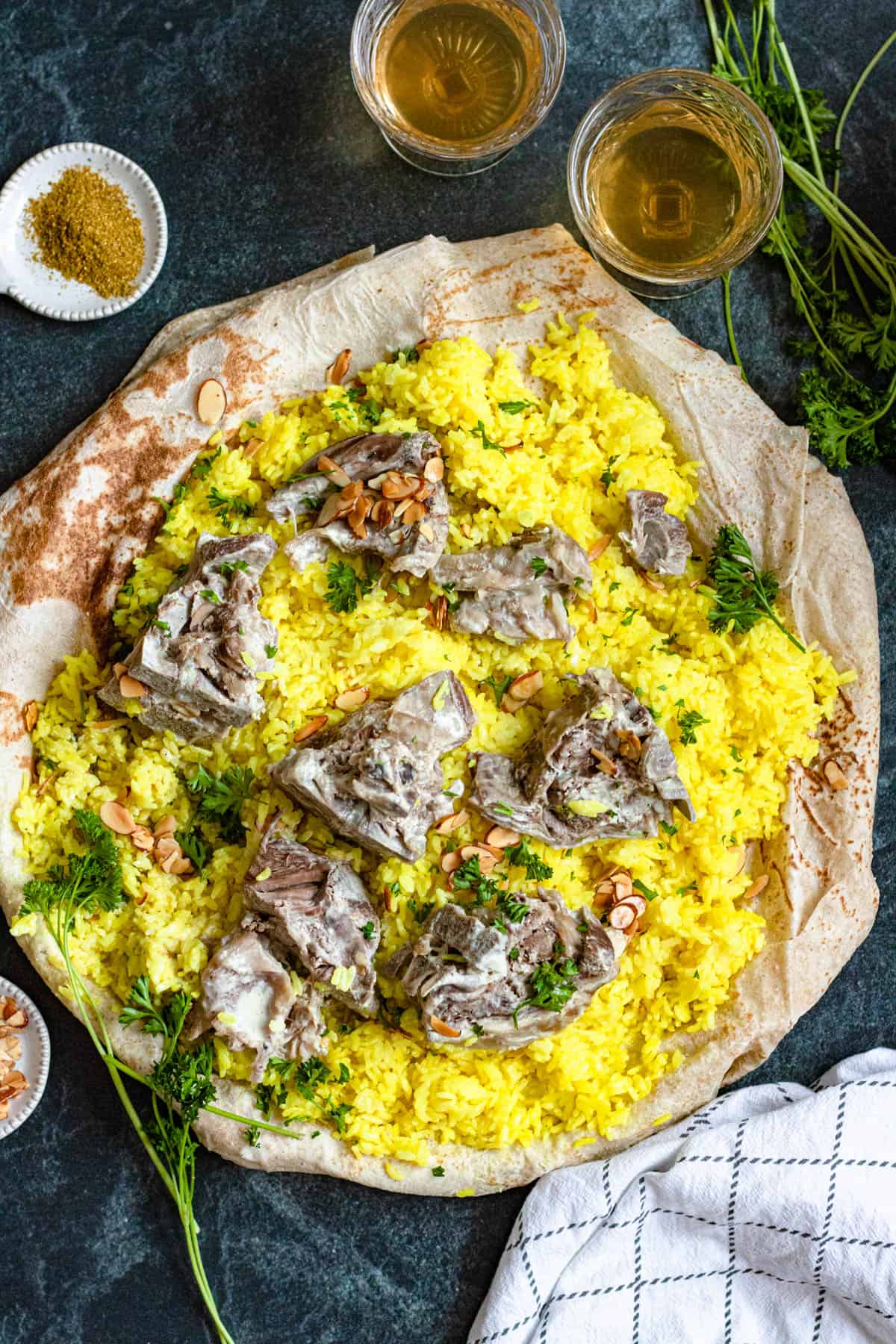
To Serve – cover a large serving platter with 2-3 pieces of your bread, then drizzle the bread with a bit of the jameed mixture (about ½ – ¾ cup).
Pile the steamed rice on top of the bread. Then top with the strained, cooked lamb meat, then the roasted almonds, and finally, some parsley for garnish.
Use the remaining sauce for each individual portion if desired. Enjoy!
The recipe was researched using Middle Eats, MamaInTheKitchen, & The Cookbook.
The recipe was edited and approved by Christina Besharat and Lucy Besharat.
Traditional Serving
Authentic mansaf is piled on a large platter for guests to gather around and eat all together–as if off of one giant plate.
Guests would take a bit of lamb, yellow rice and the soaked bread with their right hand (the left hand is considered dirty and should not be used) and gently work it into a bite-sized ball.
The trick is to use three fingers to put the ball into your mouth without letting your fingers touch your lips. This helps keep fingers clean.
While some men still enjoy mansaf in this manner, it’s more common now for guests to spoon a portion onto a plate and eat it with a fork.
Expert Tips

- When you are stirring the jameed you have to be in good spirits or else it will curdle! This seems like it’s an old wives tale, but our recipe editors swear it is important and every time they have made this meal while upset, it has not turned out correctly.
- Do now allow your jameed mixture to boil or it may curdle!
- Other recipes call for jasmine rice, but our recipe editor prefers short-grain rice. You can choose your own preference. If using jasmine rice, use 3 ¾ cups of stock instead of 3 ⅓.
- Your jameed sauce should be the consistency of thin gravy.
- Though the traditional meat to use is lamb, you can also use beef if necessary.
What Do You Serve With Mansaf?
Mansaf is often served with an extra side of yogurt sauce so guests can sprinkle more over their own plate or even drink it like soup.
Did you enjoy this Jordanian Mansaf Recipe? If so, make sure to check out these other recipes I picked out just for you:
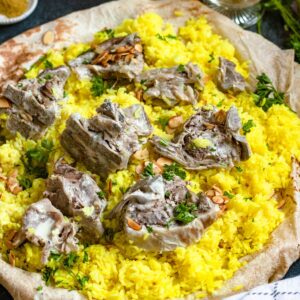
Jordanian Mansaf Recipe
Equipment
- Pot(s)
- Pressure Cooker (optional)
- Platter
Ingredients
- 2-3 lb bone-in lamb shoulder, cut into large pieces
- Distilled white vinegar, to clean lamb
- 2 small yellow onions, whole
- 6 bay leaves
- 10 cardamom pods
- 2 tbsp ghee, divided
- Salt, to taste
- ¼ tsp turmeric
- 2 ½ cups calrose rice, soaked for 1 hour and rinsed
- 17.6 oz liquid Jameed, from inside the larger box (soup starter)
- 16 oz Whole Milk Yogurt
- 1 tsp maqluba spice
- ¼ cup Blanched almonds
- 2-3 pieces Saj, Markook or Lavash bread
- Parsley for garnishment
Instructions
Lamb
- Rinse 2-3 lbs of lamb meat with water and splash with distilled white vinegar. Rub the vinegar into the lamb, then rinse with more water.
- Put the lamb in a large pot and then pour in enough water to completely cover the lamb.
- Put the lid on and boil the lamb for ten minutes. You should notice foam forming at the top of the pot. Make sure to skim this foam off of the top of the water.
- After 10 minutes, dump the boiling water out. Then rinse the meat again, and add it to a pressure cooker with the 2 small yellow onions, 6 bay leaves, and 10 cardamom pods. Fill the pot with enough water to completely cover the contents of the pot.
- Set the pressure cooker to high for 30 minutes (with a quick release). If using the stovetop method instead of the pressure cooker, return the lid to the pot and allow it to boil for 1-2 hours.
- The stock is done when the meat is tender and a butter knife can easily poke through the meat. Strain and reserve the stock and set the stock and meat aside.
Rice
- Once the meat is done, add 1 tbsp ghee to a medium pot. Allow the ghee to melt, then add salt to taste and ¼ tsp turmeric.
- Add the 2.5 cups soaked and drained rice and stir to toast in the ghee for a few minutes.
- Add 3 ⅓ cups of the reserved stock into the pot with the rice. Bring the water to a boil, uncovered, then reduce to a simmer.
- Turn the heat to low, put a lid on the rice and cook until the water is absorbed and the rice is cooked (about 15 minutes).
Jameed
- Pour your 17.6 oz jameed into a small pot, then add the 16 oz yogurt and about 1 cup of the reserved stock.
- Let this mixture come to a simmer for about 10 minutes. Mix carefully. Do not boil it and do NOT cover the pot.
- When the jameed has simmered for 10 minutes, add 1 tsp maqluba spice and the lamb pieces into the pot and simmer for another 10 minutes.
- When the 10 minutes are up, remove the lamb from the jameed and set both aside.
Almonds
- Heat another 1 tbsp of ghee in a pot and melt. Then add ¼ cup blanched almonds. Stir until the almonds are toasted.
Serving
- To Serve – cover a platter with 2-3 pieces of your bread, then drizzle the bread with a bit of the jameed mixture (about ½ – ¾ cup).
- Pile the steamed rice on top of the bread. Then top with the strained lamb meat, then the roasted almonds, and finally, some parsley for garnish.
- Use the extra jameed sauce for each individual portion if desired. Enjoy!
Notes
The recipe was edited and approved by Christina Besharat and Lucy Besharat. Copyright The Foreign Fork. For educational or personal use only.
- Bone-in lamb shoulder, cut into large pieces: I went to my local Middle Eastern grocery store and asked for lamb shoulder. The butcher counter was able to cut the meat into 4-6 inch pieces for me (I told them I was making Mansaf, and they knew how to cut it!).
- Distilled White Vinegar: To clean your lamb.
- Calrose Rice: This is a short-grain white rice that our recipe editor recommends for the best results! Other recipes sometimes call for jasmine rice.
- Liquid Jameed: See the “What is Jameed” section below for more information.
- Whole Milk Yogurt: You do not need Greek yogurt. Instead, use regular, whole-milk yogurt.
- Maqluba Spice: I found this at my local Middle Eastern grocery store but you can also find it online. If you cannot find it, you can omit it.
- Saj, Shrak bread, Markook, or Lavash bread: This is a very thin bread, thinner than a tortilla. You could use tortillas or pieces of flatbread if you cannot find these other breads.
- Parsley: For garnishment
- When you are stirring the jameed you have to be in good spirits or else it will curdle! This seems like it’s an old wives tale, but our recipe editors swear it is important and every time they have made this meal while upset, it has not turned out correctly.
- Do now allow your jameed mixture to boil or it may curdle!
- Other recipes call for jasmine rice, but our recipe editor prefers short grain rice. You can choose your own preference. If using jasmine rice, use 3 ¾ cups of stock instead of 3 ⅓.
- Your jameed sauce should be the consistency of thin gravy.
- Though the traditional meat to use is lamb, you can also use beef if necessary.



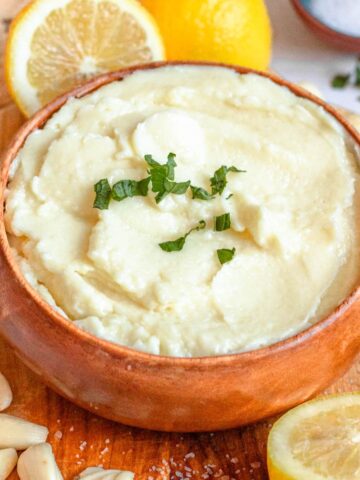
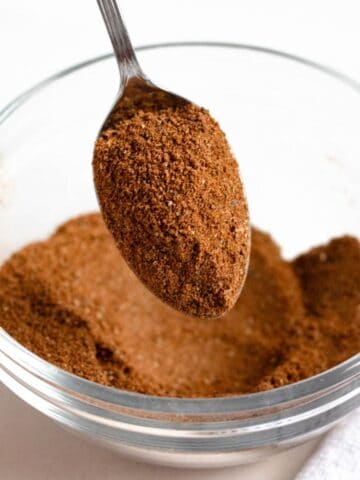

Leave a Reply